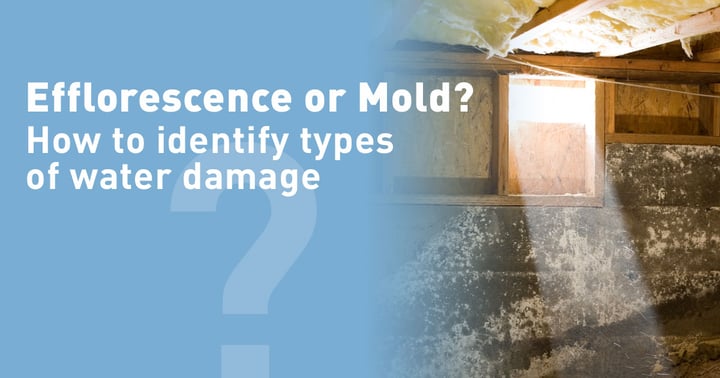Efflorescence or Mold? Water Damage in Basements or Crawl Spaces
Understanding and Mitigating Unseen Moisture Issues in Your Home
 I heard an unfortunate story recently about a pair of new homeowners who hadn’t properly inspected their basement before they moved in. While the home was mostly in good shape, with a sound roof, a recently remodeled kitchen, and new floors throughout, it only took three months of living there to realize they may have overlooked some troubling signs in their walk-in basement and in the crawl space under the breezeway.
I heard an unfortunate story recently about a pair of new homeowners who hadn’t properly inspected their basement before they moved in. While the home was mostly in good shape, with a sound roof, a recently remodeled kitchen, and new floors throughout, it only took three months of living there to realize they may have overlooked some troubling signs in their walk-in basement and in the crawl space under the breezeway.
They noticed a white material on the basement walls that was damp to the touch, and upon further inspection, they found a similar substance in the crawl space. Although the crawl space would not be regularly used (or even the basement for that matter), it was still an issue they needed to address before it became a health risk.
Besides identifying the source of the moisture, it was important for the homeowners to determine whether the white substance in question was a case of efflorescence or a more harmful mold, both of which result from moisture intrusion. If you’ve never heard the term before, efflorescence is a salt deposit that can appear on the exterior or interior of a structure, and it’s easily mistaken for mold or mildew. For homeowners trying to troubleshoot moisture problems in their basement, understanding the difference is important to be able to treat and prevent it.
Recognizing Efflorescence in Your Basement or Crawl Space
Alkali efflorescence will appear powdery or as a crystal-like material, and it’s generally light in color. While alkali efflorescence itself is not harmful to your health or an immediate problem, it’s a sign of intruding moisture leaking through the foundation walls or of lingering humidity in an unsealed crawl space. This white powder is unsightly and forms on cement and brick surfaces when water inside the wall leaks out and evaporates, leaving behind the tell-tale traces of salts deposits.
It’s important to note that, over time, efflorescence can affect the integrity of the wall or surface, causing it to flake or gradually crumble away. This not only puts the wall at risk of deteriorating, but it also increases the chance for more water to seep through. Because of that, you should remove any signs of it immediately by sandblasting or using a stiff wire brush with special chemical cleaners.
If you still have recurring issues with efflorescence on basement and crawl space walls after you’ve cleaned it, this means there’s a leak in the wall where water and moisture are still moving through and mixing with soluble salts within. So beyond removing the efflorescence itself, the lingering moisture needs to (1) be removed, and (2) be prevented from migrating back into the space. I’ll talk about how to do that second part below, but first, let’s talk about how to tell if the mysterious substance in your basement is actually the more dangerous mold.
How to Determine If There’s Mold
If you find efflorescence on your basement walls or in the crawl space, it’s highly likely that mold is lurking nearby. While mold may be light in color like efflorescence, it won’t have the appearance of a powder, and it also won’t dissolve in water when a brush is applied to it. A quick test with water and a rag or brush will let you know if the substance in question is mold or not.
Mold and mildew will have a slimier texture and may present itself in different colors, depending on the surface substrate and the nutrient source. Similar to efflorescence, it’s crucial to remove any mold from basement walls when it’s first spotted. Should the basement be damp and full of moisture, mold will quickly spread and become a much bigger issue if not addressed in a timely fashion. Because mold can pose a lot of health concerns, you should always test for mold before working in any space.
Preventing Further Moisture at the Source
A lot of homeowners don’t think of it this way, but a crawl space is a part of the inside of the building — only a single floor separates it from the interior of the home. So if an unsealed crawl space is humid, wet, or damp, there’s a good chance those conditions are going to affect the rooms directly above it. Water can find a way through cracks, and moisture vapor can find a way through any porous system, including concrete walls or concrete blocks of a foundation.
Vented crawl spaces and those with dirt floors are particularly prone to high levels of humidity because they’re more open to the elements, and depending on the climate zone, that humidity can be difficult to control and can lead to much bigger issues down the road for the homeowner.
That’s why it’s so important to prevent moisture from entering these lower sections of a house. One of the best ways to do that is to install a moisture vapor barrier, ideally one made of high-grade virgin polyolefin resin. These types of barriers are designed to prevent unwanted moisture from re-entering the crawl space, ensuring it remains comfortable, dry, and free from efflorescence and mold for a long time. It can be applied over unsealed crawl space ground, making it an ideal solution for crawl spaces that have humidity and moisture concerns.
Should you find efflorescence or mold in your crawl space, it’s safe to say there’s a moisture issue which needs to be addressed. Once all lingering substances and moisture are removed and the floor and walls of the crawlspace are securely encapsulated with a vapor barrier system, you can rest assured your property and your investment is protected from further effects of moisture like efflorescence or mold.
Editor's note: This blog post was initially published in July 2016 and has been revised to stay up-to-date.

Written by Tom Marks
Tom Marks is the Business Development Project Manager with Stego Industries, LLC. He has been with Stego since 2007, serving many years as the Rocky Mountains Regional Manager. Now, his focus is geared toward vapor barrier solutions for new and existing homes as the Product Manager of the StegoHome and StegoCrawl brands. In addition, Tom serves as Sustainability Manager, overseeing Stego’s leadership in holistic product and corporate sustainability. Tom enjoys working with a wide range of project team members and customers to incorporate effective sub-slab vapor protection and create healthy, sustainable homes and buildings.
- Stego (26)
- StegoCrawl (24)
- Stego-Awareness (17)
- StegoHome (15)
- Case Studies (14)
- StegoCrawl-Consideration (12)
- StegoCrawl-Awareness (11)
- Customer Stories (9)
- Stego-Consideration (9)
- Pango (8)
- StegoHome-Consideration (8)
- Beast (7)
- How to Install (7)
- StegoHome-Awareness (7)
- Drago (5)
- Pango-Awareness (5)
- Beast-Awareness (4)
- Beast-Consideration (3)
- Drago-Awareness (3)
- Pango-Consideration (3)
- Stego IQ (3)
- Drago-Consideration (2)
- StegoCrawl-Decision (2)
Popular Posts
Stay Connected.
Enter your email below.








Post Comments